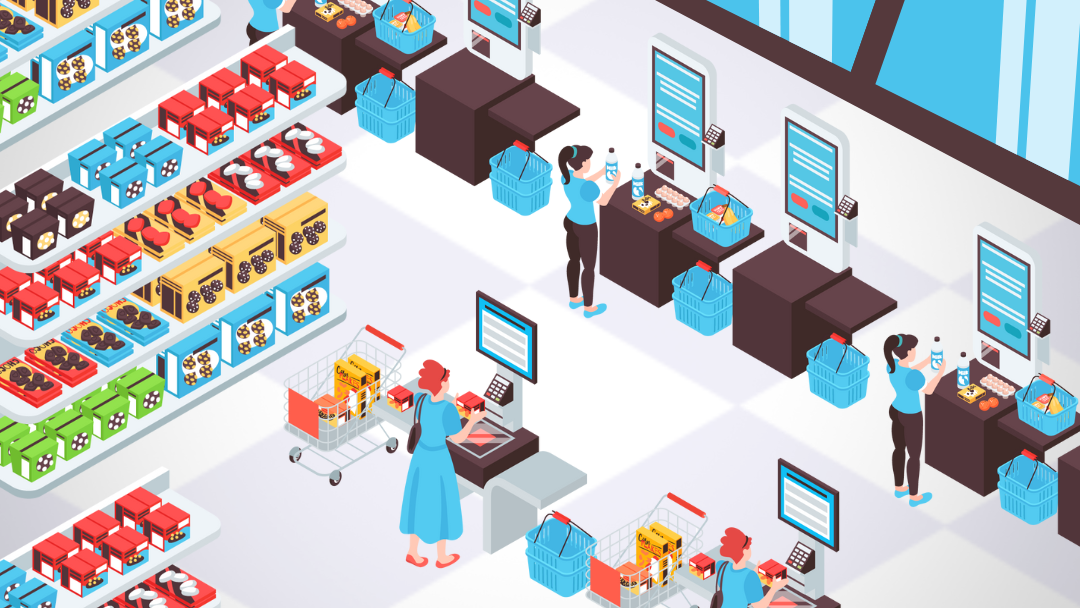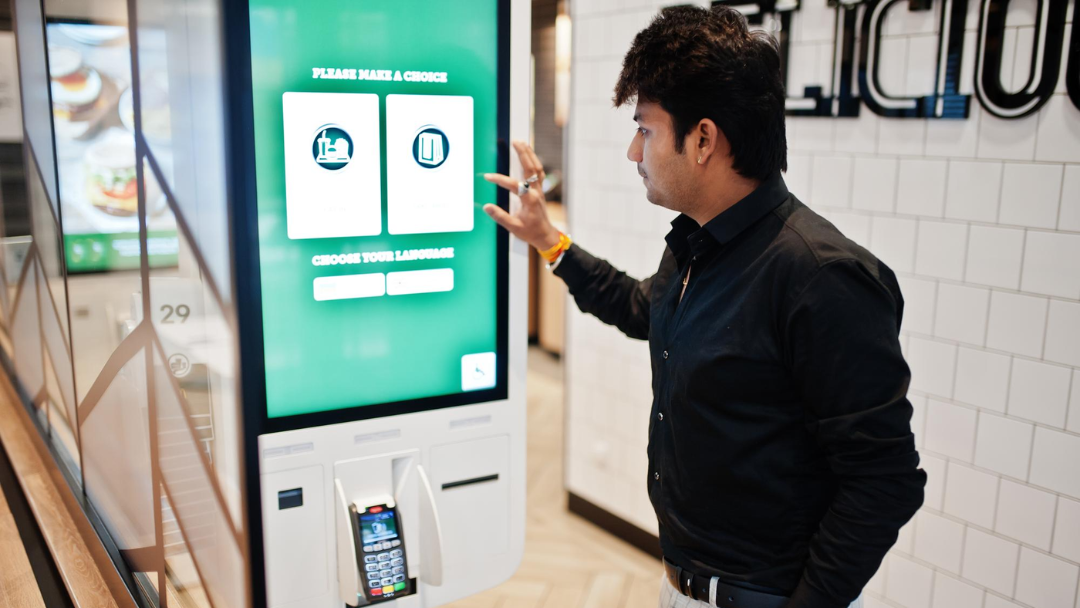Are you fed up with the long queue for billing after your shopping is done? Do these long queues and the waiting period make your shopping experience awful? Don’t worry, This guide will help you on how to use the self-checkout system for a hassle-free shopping experience.
What is a self-checkout system in the retail business?
A self-checkout system in retail is a technology solution that allows customers to scan and pay for their purchases without interacting with a cashier or salesperson. It typically consists of several self-service kiosks equipped with barcode scanners, touchscreens, and payment terminals. Customers can simply scan the barcodes of their items, bag them, and complete the transaction by paying with cash, credit/debit cards, or mobile payment methods. Self-checkout systems aim to provide a faster and more convenient checkout experience for customers while reducing staff requirements for the retailer.

What are the advantages of a self-checkout system?
Faster checkout process: Self-checkout systems can be quicker than waiting in line at a traditional checkout counter. Customers can scan and bag their items themselves, eliminating the need to wait for a cashier to ring up each item individually.
Increased efficiency: Self-checkout systems allow stores to better manage their staffing needs. With fewer cashiers required, employees can be allocated to other areas of the store, improving overall operational efficiency.
Improved customer convenience: Self-checkout systems provide customers with the convenience of being in full control of their shopping experience. They can scan and bag items at their own pace, without relying on a cashier.
Reduces human error: Self-checkout systems can minimize the likelihood of human errors, such as miscounts or charging incorrect prices for items. The automated process ensures accuracy in scanning and pricing.
Integration with loyalty programs and coupons: Self-checkout systems can be integrated with loyalty programs, allowing customers to easily earn and redeem rewards points. Additionally, customers can conveniently use digital coupons at self-checkout stations, saving time and effort.
Promotes social distancing: In times of social distancing, self-checkout systems can help reduce face-to-face contact between customers and cashiers. This can contribute to the overall safety and well-being of both customers and employees.
Enhanced privacy: Some customers may prefer using self-checkout systems to maintain their privacy, especially when purchasing personal or sensitive items. Using self-checkout can offer a level of privacy that may not be possible with a cashier.
Increased accessibility: Self-checkout systems are often designed with accessibility features, making them easier for people with disabilities or mobility challenges to use. These features can include larger buttons, better visibility, and audio instructions to accommodate different needs.
Efficient for small basket purchases: Customers with a few items can benefit from self-checkout systems as they can quickly complete their transactions without having to wait in line behind customers with larger carts.
Training and skill development: Self-checkout systems provide an opportunity for customers to learn and gain confidence in using technology. This skill development can be beneficial in an increasingly digital and automated world.
What are the risks involved in the self-checkout system?
There are several risks to using self-checkout systems. Some of the common risks include:
Theft: Self-checkout systems are prone to theft due to loopholes in the scanning and payment process. Customers may intentionally or unintentionally fail to scan all items or swap expensive items with cheaper ones, resulting in a loss for the retailer.
Technical issues: Self-checkout systems rely on technology, such as barcode scanners and payment terminals, which can malfunction. Technical glitches may lead to incorrect scanning, overcharging, or payment failures, causing inconvenience to customers and potential loss of business for the retailer.
Increased shoplifting: Self-checkout systems may encourage shoplifting as there is minimal human supervision. Customers may exploit this and intentionally avoid scanning or paying for items, leading to increased losses for the retailer.
Errors in scanning: Customers may inadvertently or purposefully scan items inaccurately, leading to incorrect pricing or incorrect inventory management. This can affect sales data, inventory control, and profit margins.
Loss of personalized service: Self-checkout systems eliminate the need for human cashiers, reducing personal interactions between customers and store employees. This might result in a loss of personalized service, leaving some customers feeling less satisfied with their shopping experience.
Complexity for some customers: Elderly or technologically challenged customers may find self-checkout systems complicated or difficult to use. This can cause delays, frustration, and potential loss of sales.
Retailers need to carefully assess and manage these risks by implementing security measures, providing proper training to customers and employees, conducting regular system maintenance, and providing alternative options for customers who prefer traditional checkout methods.
How to implement a self-checkout system in Retail?
Implementing a self-checkout system in a retail store involves several steps. Here’s what needs to be done:
Research and select a self-checkout solution: Look for self-checkout systems that suit your store’s specific needs and budget. Consider factors like hardware requirements, software features, integration capabilities, customer experience, and support services.
Prepare the store layout: Assess your store’s physical space and determine where the self-checkout stations will be placed. Ensure the area is easily accessible, well-lit, and provides enough room for customers to scan and bag items.
Purchase and install the necessary hardware: Acquire the self-checkout kiosks, barcode scanners, payment terminals, weigh scales, bagging stations, and security systems needed for the implementation. Follow the installation instructions provided by the vendor, or hire professionals if necessary.
Integrate the self-checkout system with your existing infrastructure: Depending on your store’s Point of Sale (POS) system, you may need to integrate the self-checkout solution with your inventory management, product databases, and payment processing systems. Work closely with your self-checkout system provider and IT department to ensure seamless integration.
Train employees: Train your staff on how to support customers using the self-checkout system. They should be knowledgeable about the technology, understand any troubleshooting steps, and be able to assist customers when needed.
Promote the self-checkout option: Inform customers about the new self-checkout system. Use signage, digital displays, and announcements to let them know about the convenience and benefits of using self-checkout.
Monitor and maintain the system: Regularly monitor the self-checkout stations to ensure they are working properly, have sufficient supplies (e.g., receipt paper, shopping bags), and are free of any defects. Address any issues promptly, and provide ongoing training and support to your staff.
Evaluate and make improvements: Gather customer feedback and analyze data about the use of self-checkout in your store. Identify areas for improvement, such as user experience, system reliability, or staff training, and make necessary adjustments to enhance the overall self-checkout process.
Remember that implementing a self-checkout system may have different requirements depending on the specific solution you choose and your store’s unique circumstances. It’s essential to be thorough in your research, plan meticulously, and coordinate with the appropriate vendors and internal departments to ensure a successful implementation.
Summing Up: Should You Choose Self-Checkout?
A self-checkout system is a technology that allows customers to scan and pay for their purchases without the assistance of a cashier. It is typically found in retail stores and supermarkets and has become increasingly popular in recent years.
Self-checkout systems also offer benefits to retailers. They can help reduce labor costs by requiring fewer cashiers and reallocating employees to other areas of the store. Additionally, these systems can potentially increase sales by expediting the checkout process, allowing customers to make more frequent purchases.

